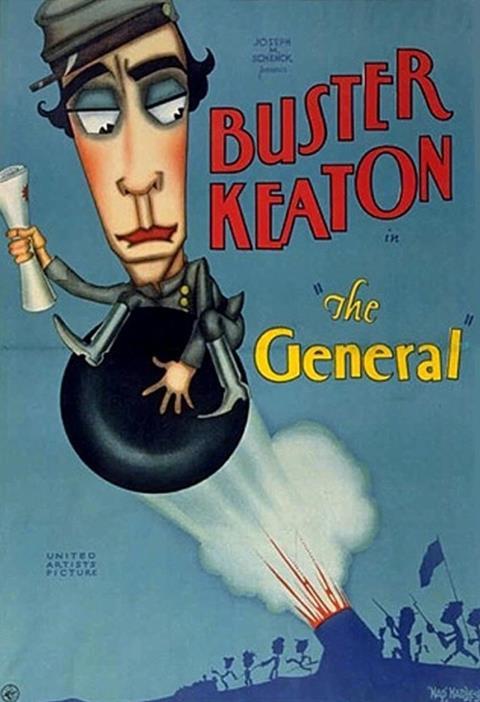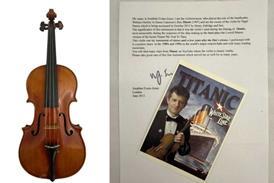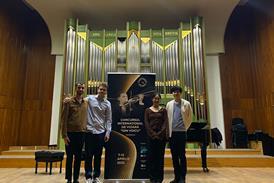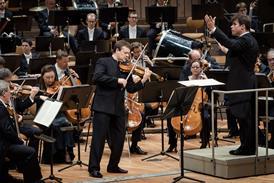US correspondent Thomas May speaks with the Telegraph Quartet about their upcoming performance of Stephen Prutsman’s new score to accompany a screening of the classic Buster Keaton silent film The General.

Discover more Featured Stories like this in The Strad Playing Hub
The Telegraph Quartet (Eric Chin and Joseph Maile, violins; Pei-Ling Lin, viola; Jeremiah Shaw, cello) continues its ongoing collaboration with composer and pianist Stephen Prutsman with a live performance of Prutsman’s film score to The General, a classic Buster Keaton silent film from 1928. The showing takes place on 1 December in a concert presented by Noe Music at Noe Valley Ministry in San Francisco, the Telegraph Quartet’s hometown. This will be the West Coast premiere of the new film score.
Prutsman, who has also collaborated extensively with the Kronos Quartet, has also worked as a pianist and arranger outside the classical world with diverse artists such as Tom Waits, Rokia Traore, Joshua Redman, Jon Anderson of YES, Sigur Rós and Asha Bhosle. His score to the Buster Keaton film is for piano quintet.
‘Keaton’s films have such a graceful perfection, such a meshing of story, character and episode, that they unfold like music’, wrote the legendary American film critic Roger Ebert in 1997. ‘The General is an epic of silent comedy, one of the most expensive films of its time, including an accurate historical recreation of a Civil War episode, hundreds of extras, dangerous stunt sequences, and an actual locomotive falling from a burning bridge into a gorge far below. It was inspired by a real event; the screenplay was based on the book The Great Locomotive Chase, written by William Pittenger, the engineer who was involved’.
The members of the Telegraph Quartet, who have teamed up with Prutsman for several other film screenings accompanied by live music, spoke about working with their colleague and the logistics of working with cinema.

What inspired this project?
Eric Chin: We’ve worked with Steve on numerous projects, including several of his film scores. It has been such a blast that when he asked us to do The General, of course we said yes. This is the first of his wonderfully vibrant film scores that we will be premiering on the West Coast. Whether we’re performing his original compositions with Steve or a classic such as the Schumann Piano Quintet, the experience with Steve is always genuine and rewarding.
How often does the Telegraph Quartet take on cinematic projects like this?
Jeremiah Shaw: I wouldn’t say it’s a typical TQ performance, but something that is becoming more familiar to us as this will be the fifth Stephen Prutsman silent film score that we will have performed, three of which were piano quintet scores for Buster Keaton films. The other two were quartet scores written for more serious films with a darker tone.
What is special about Prutsman’s score?
Pei-Ling Lin: Steve’s music has such vibrant characters and flavours that you can sense it right away from the strike of the first chord. One aspect of Steve’s style I particularly love is the glamour of Hollywood Golden-Age texture and orchestration in his score. In the several silent films we have done with Steve, the music and the cinema have felt like two mirrors set up facing one another: they really enhance and echo each other’s effects.
How does the music reflect or react to the film?
Joseph Maile: Steve draws on the vaudevillian musical style of the era as inspiration for the music, with ragtime, waltzes, and fanfares abounding. He really transports you back into that time period and perfectly amplifies the ingenious comedic effects of Buster Keaton – both the outlandish slapstick and the more subtle expressions that make the film so effective even 100 years later. Steve is always inserting fun musical Easter eggs, often with clever anachronistic references for the alert listener.
Regarding the logistics of playing live to a film: who leads? How does that work?
Eric Chin: For this particular score and film, we will be using a click track to guide us as our fearless digital leader. The story is what leads us. In a situation where there is no click track, we would just go, in the case of a silent film, with the film. Whoever has the best view of the film as we play will give the cues.
Jeremiah Shaw: We use a click track in order to stay synched with the action of the movie. This click changes tempo and time signatures throughout and, depending on the score, will even call out bar numbers periodically. With that said, we have performed some of these scores without the click track, following Stephen Prustsman’s lead.
How do you readjust if you need to get back in sync?
Pei-Ling Lin: I find it very helpful to treat the click track as a member of the group – it’s the most accurate and unfeeling player. In performance, often we might be inspired to do something spontaneous and possibly out of time, and that’s when we have to go with the sound in the room, not the sound in our ear. It’s like doing any rubato – we would massage the timing around the area so we gradually (and hopefully seamlessly) get back on track with the click track.
What do you especially enjoy about these film projects?
Jeremiah Shaw: We love to get the audience itself involved just like they would have been back in the day. At at the start of the show, we encourage everyone to cheer for the hero, boo at the villain, and to get weepy in the sad spots. It keeps things loose and fun. Steve also loves to scatter sound effects to underscore fun moments in the movie, using extra toy instruments that each of us gets to play: anything from slide-whistles and kazoos to toy trumpets and spoons – all kinds of fun, wacky stuff!
There will be general notation in the score indicating where to play the effects, but often we’ll improvise on what to do and how often to do it based on the comedic moment, which can get pretty spontaneous after a few performances. It really makes for a dynamic experience on our end that we think translates into a fresh performance for the audience, too.
Read: Telegraph Quartet to take up residency at the University of Michigan
Read: Telegraph Quartet: Divergent Paths
Read: Sounds of change: Ayane Kozasa and Paul Wiancko on the new Kronos Quartet formation
Discover more Featured Stories like this in The Strad Playing Hub.
The number one source for playing and teaching books, guides, CDs, calendars and back issues of the magazine.
In The Best of Technique you’ll discover the top playing tips of the world’s leading string players and teachers. It’s packed full of exercises for students, plus examples from the standard repertoire to show you how to integrate the technique into your playing.
The Strad’s Masterclass series brings together the finest string players with some of the greatest string works ever written. Always one of our most popular sections, Masterclass has been an invaluable aid to aspiring soloists, chamber musicians and string teachers since the 1990s.
The Canada Council of the Arts’ Musical Instrument Bank is 40 years old in 2025. This year’s calendar celebrates some its treasures, including four instruments by Antonio Stradivari and priceless works by Montagnana, Gagliano, Pressenda and David Tecchler.






































No comments yet